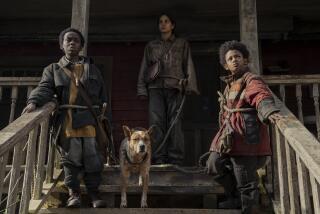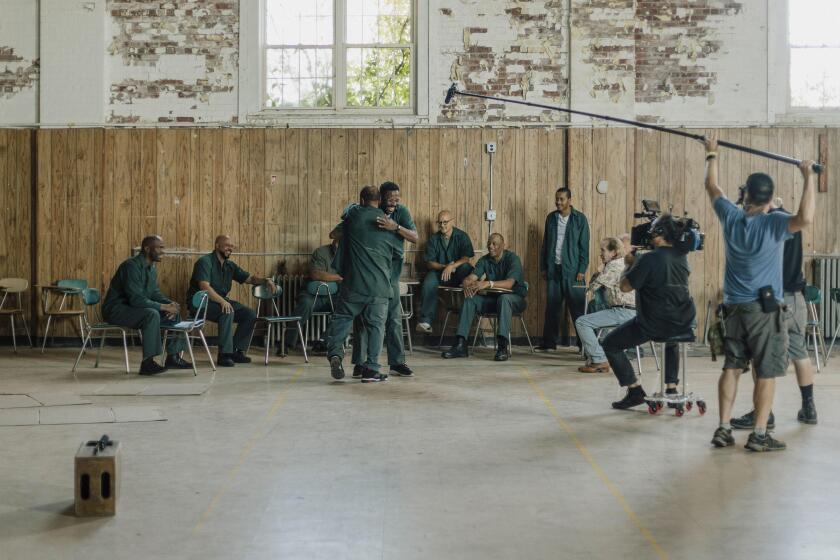Orchestrator of outsider angst
ICONOCLASTIC American director Nicholas Ray tapped into the post-World War II existential blues in a series of uncompromising films he made from the late 1940s through the ‘50s.
Though critics and audiences of the time unjustly neglected many of his films, Ray’s stock soared in subsequent decades, especially after he was warmly embraced by French New Wave filmmakers such as Francois Truffaut and by contemporary directors including Jim Jarmusch and Wim Wenders.
Ray’s male characters reflected his own anti-hero personality -- they were loners and outsiders who were frequently violent. His females were stronger, morally and spiritually, than their counterparts, whose angst they’d attempt to temper with love and understanding.
From Friday through Dec. 20, the American Cinematheque at the Egyptian Theatre will screen “In a Lonely Place -- The Rebellious Cinema of Nicholas Ray,” a 10-film retrospective that features six movies not available on DVD. The series will visit the Cinematheque’s Aero Theatre next month.
Ray, born in 1911, brought an eclectic background to his moviemaking. He studied architecture with Frank Lloyd Wright and worked with Elia Kazan in New York’s Theatre of Action and even promoted folk music with Pete Seeger before he turned to film.
Drew Casper, film professor at USC’s School of Cinema and Television, describes Ray’s canon of work as “very genre diverse.”
“In all of his work, there is a story structure,” says Casper. “Like in ‘Rebel Without a Cause,’ you have the orchestration of three parallel teenagers -- you have Natalie Wood, you have Sal Mineo and you have James Dean. The film opens at night and goes from night to day.... All of that is orchestrated.”
Ray derived his sense of structure from his architectural background, says Casper. “Frank Lloyd Wright always felt that architecture should be functional,” he says. “Space should be functional.”
The visually arresting composition of Ray’s frames was functional as well. “He used a lot of unbalanced staging,” says Casper. In “Rebel Without a Cause,” for example, the film opens with an off-kilter angle of Dean’s drunken Jim Stark lying on the ground and playing with a toy. In another scene in the 1955 drama Dean is resting on the family sofa in such a way that when he views his parents coming down the stairs, they appear to be upside down. It was unbalanced staging that represented the instability of the characters’ feelings, Casper says. Ray situated his films in middle-class households or apartments or the outposts of civilization, Casper says. “His principals, which were usually male, pretty much felt out of context,” both in their families and in society, he says.
“Some of his people are physically ill. Robert Taylor is a cripple [in ‘Party Girl’]. But they are all psychologically ill. Something is not working.”
Ray’s heroes often question accepted concepts of macho maleness. “You have Sal Mineo, who has a locker full of Alan Ladd pictures,” says Casper. “Dean is a sensitive male.”
The key to these men, he says, can be found in the line Sterling Hayden utters in 1954’s Freudian Western “Johnny Guitar” -- “I’m a stranger here myself.”
“Johnny Guitar,” which also stars Joan Crawford, is among the highlights of the Cinematheque retrospective, which also includes his first film, the 1948 noir romance “They Live by Night,” starring Farley Granger and Cathy O’Donnell; the brilliant 1952 noir “On Dangerous Ground,” which stars Robert Ryan as a quintessential Ray male -- a violent metro cop; and 1950’s “In a Lonely Place,” which features Humphrey Bogart in one of his most complex turns as an aggressive, moody screenwriter named Dixon Steele, who is accused of murdering a young woman.
Save for “Rebel Without a Cause,” most of Ray’s films didn’t make much money.
“Some things that were an ‘A’ production like ‘Party Girl’ flopped,” says Casper. “ ‘Bigger Than Life’ is very interesting, but it made no money. Look how downbeat his stuff was.”
Like his characters, Ray was his own worst enemy and would have run-ins with his studio bosses. In the case of two films in the festival, 1957’s “The True Story of Jesse James,” starring Robert Wagner and Jeffrey Hunter as Jesse and Frank James, respectively, and 1958’s period drama “Wind Across the Everglades,” the studios interfered with Ray’s vision. He was forbidden to finish “Everglades” and wasn’t allowed the final edit.
When his 1963 film “55 Days in Peking” flopped, he left the business and turned to teaching. He died of cancer in 1979 at age 67.
*
‘In a Lonely Place -- The Rebellious Cinema of Nicholas Ray’
Where: American Cinematheque at the Egyptian Theatre, 6712 Hollywood Blvd., Hollywood
When: Friday through Dec. 20
Price: $7 to $10
Contact: (323) 466-FILM or www.egyptiantheatre.com
Schedule
Friday: “Johnny Guitar,” “The True Story of Jesse James,” 7:30 p.m.
Saturday: “They Live by Night,” “On Dangerous Ground,” 6 p.m.; “In a Lonely Place,” “Party Girl,” 9:30 p.m.
Next Sunday: “Bigger Than Life,” “Wind Across the Everglades,” 7:30 p.m.
Dec. 20: “Rebel Without a Cause,” “Bitter Victory,” 7:30 p.m.
More to Read
Only good movies
Get the Indie Focus newsletter, Mark Olsen's weekly guide to the world of cinema.
You may occasionally receive promotional content from the Los Angeles Times.











